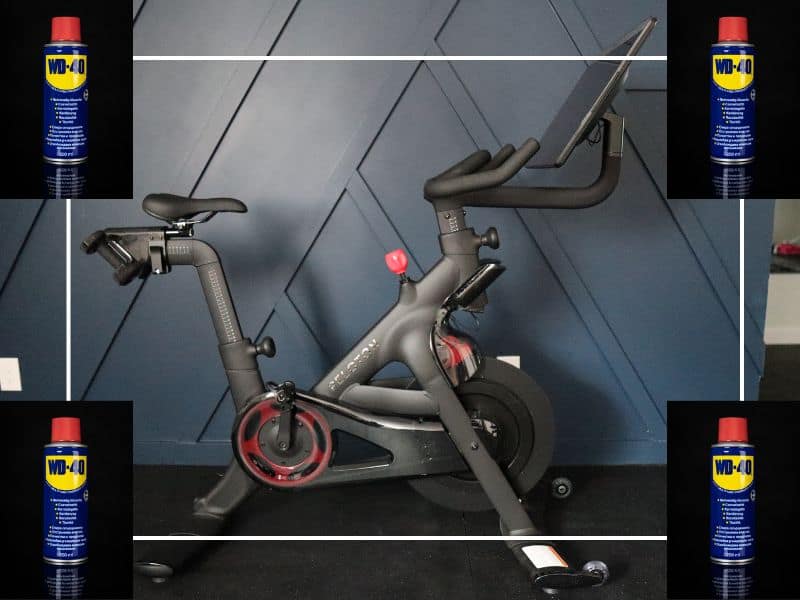WD-40 produces a range of products for degreasing, rust prevention, and overall conditioning of metal gizmos with moving parts. They are widely available and popular among consumers. This familiarity and convenience make them seem compelling for keeping a stationary bike in tip-top shape.
WD-40 is a multi-purpose suite of metal de-greasers that work in various contexts, including the maintenance of stationary bikes. Care should be taken to abide by the manufacturer’s guidelines, especially for in-warranty devices. The sensitive computer areas of the device should be protected.
We’ll list the questions to navigate in deciding whether and how to use WD-40 to enhance your stationary bike’s roadworthiness.
The Pros Of Using WD-40 On A Stationary Bike

WD-40 lubricants are widely available and have been a staple in the maintenance of road bikes. They are shipped in the form of a spray that uses the principle of water displacement, repelling crevices by entering the place and replacing the moisture. This action has two consequences, expelling water and grime from tight crevices.
The result is a reduction in the likelihood of rust – since water is required for rust, and smoother functioning of moving parts, as the friction-inducing grime is removed. These effects make the bike function smoother and maintain reduce the likelihood of rust.
Because some stationary bikes are constructed by hand, using the components of disused road bikes, WD-40 can be applied in the same contexts as on-the-road bikes. Whatever benefits the user experiences on the road bike transfers to the stationary application.
The Cons Of Using WD-40 On A Stationary Bike

Manufactured road bikes are a different story, and generally, it is inadvisable to apply WD40 to them. One of the adverse effects of applying WD-40 to bicycle chains is that it can cause dust and grime to stick to the chains. Over time this compounds the problem that was meant to be addressed.
A safer alternative is to use gentler bike-specific lubricants and follow a consistent preventative maintenance regime.
Factors To Consider When Using WD-40 On A Stationary Bike
When weighing whether or not to use WD40 on a stationary road bike, regard should be had for the factors listed below.
The Manufacturer’s Advice
Several stationary bike manufacturers explicitly advise against using WD-40 on their equipment. Usually, this warning is based on an awareness of the materials used in the construction of the bike and the adverse chemical effects of using those materials on the instrument. If your manufacturer issues such warning, this should end any thought of using WD-40 on your stationary bike.
Peloton Bike Example

For example, nowhere on Peloton’s website do they recommend using any type of lubrication on their spin bikes. They have very specific instructions on how to care for and maintain the bike and none of those steps include using WD-40. Because of this I would advise staying away from using any type of lubrication as it may further damage the bike. If you are within the warranty period adding lubrication to the Peloton bike will void the warranty.
The Importance Of The Warranty

If your bike is under warranty, violating the manufacturers’ guidelines may void the protection provided by the warranty, effectively increasing the acquisition cost of the bike. Check the details to see if using unrecommended products exposes you to out-of-warranty risks.
The Condition Of The Bike
The older and more handmade the bike, the likelier it is to get away with using WD-40 on the stationary bike. WD-40 is penetrant, and repeated use will affect the bike’s materials.
Some apparent use cases for WD-40 stem from squeaks and squeals in the moving parts. Such impairments of smooth functioning often relate to poor alignment of the bike. Here WD40 will not address the underlying issue. Continued use of a misaligned bike will continue the harmful stress on the affected parts. The grinding noises should be a warning sign and not be sprayed away.
The Sensitive Parts

Increasingly, stationary bikes have computer equipment that is integral to the functioning of the machine. These sensitive electronics – and their enclosing materials – can be harmed through contact with solvents like WD-40. The best way to avoid such accidental contact is by not using WD-40 at all.
Health Risks
Normal use of WD-40 poses no remarkable health risks. However, ingestion and direct contact with the skin may include respiratory irritation, nasal distress, and central nervous system ailments such as headaches. Many stationary bikes are stored at home, and if it is not possible to reliably stash the WD-40 out of reach of small children, it should be avoided.
Conclusion
By considering the factors listed above, while pursuing a conservative approach, it is possible to affect the proper application of WD-40 to the care of your bike. Overall, the best strategy is to carry out regular preventative maintenance on the bike – frequently dusting and wiping with gentle cleansers.






